Manuscript accepted on :15-10-2021
Published online on: 09-11-2021
Plagiarism Check: Yes
Reviewed by: Dr. Daya Shankar Gautam
Second Review by: Dr. M Mohan Varma
Final Approval by: Dr. I an james martin
Baljeet Yadav1*  , Anu Singla2
, Anu Singla2 , Neeharika Srivastava1
, Neeharika Srivastava1  and Pawan Gupta2
and Pawan Gupta2
1Department of Forensic Science, GD Goenka University, Gurugram, India, 122004
2Institute of Forensic Science, Bundelkhand University, Uttar Pradesh, India, 284128
Corresponding Author E-mail: baljeet291090@rediffmail.com
DOI : https://dx.doi.org/10.13005/bpj/2320
Abstract
Forensic Botany helps in linking the location, type of crime, revealing modus Operandi, culprit as well as victim by various circumstantial facts. In the study, Datura stramonium was considered as major plant of Bundelkhand region encountered in poisoning cases in criminal Investigations. Datura plant was identified and its fresh leaves were washed to remove dirt, stored at 40C and were subjected to microscopic examination for botanical features, preliminary screening for alkaloids identification and chromatographic techniques such as TLC and GCMS for qualitative analysis of toxins present in the plant. The result showed that all techniques applied are suitable to identify the plant through botanical derived evidences such as leaf traces, resins, or plant extracts during the crime scene investigations. GCMS technique identified the main toxins and resulted that it contains high concentration of hyoscine and very fatal when administered eventually causes death.
Keywords
Datura Stramonium; Forensic Toxicology; GC-MS; Phytochemicals; TLC
Download this article as:| Copy the following to cite this article: Yadav B, Singla A, Srivastava N, Gupta P. Pharmacognostic and Phytochemical Screening of Datura stramonium by TLC and GC-MS: A Forensic Approach. Biomed Pharmacol J 2021;14(4). |
| Copy the following to cite this URL: Yadav B, Singla A, Srivastava N, Gupta P. Pharmacognostic and Phytochemical Screening of Datura stramonium by TLC and GC-MS: A Forensic Approach. Biomed Pharmacol J 2021;14(4). Available from: https://bit.ly/3qjCnWY |
Introduction
Forensic Botany deals with the study of the plant science and is derived as botanical evidences in court of law for criminal administration purposes. From the historical point of view, plants and its extracts has been used as important tool as modus operandi in crimes such as, human poisoning, cattle poisoning and cattle revenge etc. Such type of botanical evidences can be found in suicidal, homicidal and accidental poisoning1. The plant derived botanical evidences may be Pollens grains, leaves, stem root, sap, resins and others encountered during crime scene investigations.
Forensic Botany helps in linking the location, type of crime, revealing modus Operandi, culprit as well as victim by various circumstantial facts. There are various toxic plants grow very easily as aggressive weed in the temperate regions such as Datura stramonium, Abrus preactorious, Argemmone mexicana, Jatropha curcas, Ricinus communis, Nerium oleander etc. In the present study, Datura stramonium has been considered as major plant encountered in poisoning cases in criminal Investigations2.
Datura stramonium also called as Jimson weed, angels trumpet, thorn apple, and devil’s trumpet and many other names is an annual poisonous plant. Its seeds, leaves, roots almost whole plant is poisonous and contains various poisonous compounds like atropine, hyoscyamine, and scopolamine3.
Taxonomical Features of Datura
Datura stramonium belongs to family solanaceae, a nightshade family. Its origin is basically in North America. Its name was given by Carl Linnaeus also known as father of taxonomy. Leaves of it are coarse wavy at margin and are generally broad in length. Roots are long branched and thick4. The fruit of Datura stramonium is oval in shape and thorny in nature which contains many dark brown seeds. Flower of the plant is funnel shaped and generally white in colour.
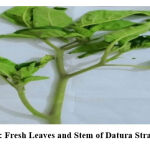 |
Figure 1: Fresh Leaves and Stem of Datura Stramonium |
Toxicity of Datura Plant
The Datura plant is very toxic in nature therefore the chances of poisoning is more abundant during criminal investigations5. The Datura plant has toxic components in its all parts like leaves, seeds, stem and flowers6. The main toxic components of the Datura are scopolamine/ Hyoscine, Atropine7. 50/100 seeds contain 3-6mg of atropine and each seed contains 0.1mg of atropine 8.
Pharmacognostic effects of Hyoscine/ Scopolamine
When hyoscine/scopalamine as main constituent is administered in body has some adverse effects such as Nausea, Headache, unconsciousness, ulceration, high blood pressure, unable to breath, weakness, fatigue, are some common early symptoms9. Long effects such as Tachycardia, Dementia, Arrhythmia, Urinary retention, Blurred vision and dry mouth drowsiness10.
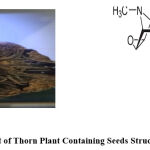 |
Figure 2: Dried Fruit of Thorn Plant Containing Seeds Structure of Hyoscyamine |
Materials And Methods
Collection of Plant
The plant Datura stramonium fresh leaves were collected from Jhansi city of Bundelkhand region 25.4484° N Longitude and 78.5685° E Latitude at normal 300C and Wind N at 3 km/h, and 80% Humidity with help of weather vane and hygrometer in the month of May. The plant was identified and described taxonomy in Department of Botany, Bundelkhand University, Jhansi. In the present study, the fresh leaves were washed to remove dirt and stored at 40C in aluminium foil. The following examinations were done.
Microscopic and Macroscopic examination
Fresh leaves and stem of the plant was considered for the microscopic examination for species identification of the plant found in Bundelkhand region. Physical parameters of leaf, stem of plant were noted for species Identification.
Phytochemical study of plant
Fresh leaves of Datura plant were crushed through pestle and motor method and filtered by muslin cloth and then by Whatman filter paper. Prepared extract was used for used for phytochemical study to identify the presence of phytochemicals11. Phytochemical study of plant were analysed for presence of alkaloids, sponins, anthraquinones, flavonoids, glycosides. Presence of glycosides and other highly poly complex structures may show the toxicity of the plant through phytochemical study12.
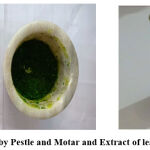 |
Figure 3: Crushing by Pestle and Motar and Extract of leaves in glass bottle |
Preparation of extracts-The extract of plant collected after filtration from muslin cloth, extract was dissolved uniformly in two different solvents such as N-Butanol and N-Hexane for Phytochemical screening. Different chemical test were performed
Chromatographic methods
TLC technique was applied for preliminary identification of toxic compounds such as Scopolamine/ Hyoscyamine13. Atropine as major constituents for toxicity of plant. In this study hyoscine was detected through thin layer chromatography TLC. Hyoscyamine-N- butyl bromide standard Rf value was compared with the extracts of the plant leaves14. In different solvent systems, chloroform: ethanol: water (81:11:8), chloroform: ethanol (3:1)15. The TLC plate was runned after spotting. Dragendroff reagent was used for visualization of alkaloids on the plate and Rf values were caluculated16.
GCMS Data Analysis
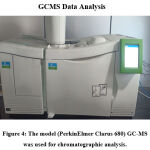 |
Figure 4: The model (PerkinElmer Clarus 680) GC-MS was used for chromatographic analysis. |
Table 1: The Acquisition Parameters Used in Operating the GC-MS.
| Serial No | Operation | Running Information |
| 1 | Oven | Initial temp 40°C for 5 min |
| 2 | Ramp | 12°C/min to 260°C |
| 3 | Hold | 10 min |
| 4 | Injection B Auto | 250°C |
| 5 | Volume | 0 μL |
| 6 | Split | 50:1 |
| 7 | Carrier Gas | He |
| 8 | Solvent Delay | 2.00 min |
| 9 | Transfer Temp | 180°C |
| 10 | Source Temp | 200°C, |
| 11 | Column | 30.0m x 250μm |
Results
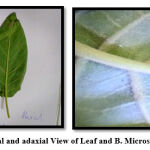 |
Figure 5: A. Abaxial and adaxial View of Leaf and B. Microscopic View of Leaf. |
Table 2: The Microscopic Properties of Plant
| Properties | Observation |
| Color | Ash Green |
| Shape | Broadly palmate |
| Size | 10-15 cm. x 7.5-12.5 cm |
| Apex | Pointed |
| Venation | Reticulate |
| Margin | Cordate |
Table 3: Phytochemical Screening of Plant in Different Extracts
| Serial No. | Chemical Test | N- Butanol Extract | N- Hexane Extract |
| 1 | Alklaoids | + | + |
| 2 | Amino Acid | + | + |
| 3 | Anthraquinones | – | – |
| 4 | Glycosides | + | + |
| 5 | Sponins | – | – |
| 6 | Flavonoids | + | + |
Note- Sign + {Present}, Sign- {Absent}
The TLC chromatogram obtained after the calculation of Rf value and was matched with standard value {0.81}.The extract shows the presence of hysocyamine. Hyoscyamine is most lethal component found in Datura stramonium.
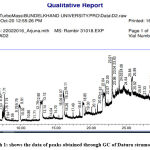 |
Graph 1: shows the data of peaks obtained through GC of Datura stramonium |
Interpretation of GC-MS Chromatogram
Table 4
| Serial No. | RT Peak | Peak % | Compounds Identified |
| 1. | 4.995 | 1.505 | Hematoporphyrin, Tungsten, Aconitane-1 |
| 2. | 6.821 | 1.307 | Hematoporphyrin |
| 3. | 9.912 | 2.365 | O-methyloxime Delsoline, Methanesulfonic acid, |
| 4. | 12.915 | 2.770 | 3-Pyridinecarboxylic acid, Hematoporphyrin Lycophyll, Rhodopin |
| 5. | 16.118 | 3.572 | Decanoic acid, Docosanoic acid, |
| 6. | 18.867 | 1.603 | Trilinolein, L-Proline, 5,5′-bis(trimethylstannyl) |
| 7. | 21.703 | 1.004 | Octadecane, 3-ethyl-5-(2-ethylbutyl), Lanosta-7,9(11)-dien-18-oic acid, Tetracosane, 12-decyl-12-nonyl- |
| 8. | 21.770 | 1.168 | Cholestano[7,8-a]cyclobutane, 3-methoxy-6-oxo-2′-methylene-, Carotene, 3′,4′-didehydro-1′,2′-dihydro-1′,2′-dihydroxy-, (2’R), Cinobufotalin |
| 9. | 21.888 | 1.061 | D-Glucopyranoside, Tungsten, 1,2-
bis(dimethylphosphino)ethane |
| 10. | 22.051 | 1.086 | cis-Vaccenic acid, Octadecenoic acid, cis-13-Eicosenoic acid, cis-10-Nonadecenoic acid |
| 11. | 23.016 | 2.509 | Atropine, O-Bromoatropine, Hyoscyamine, Atropine, acetate |
| 12. | 23.502 | 1.233 | Oleic acid, eicosyl ester, 17-Pentatriacontene, 9-Octadecene, 1-[2-(octadecyloxy)ethoxy]- |
| 13. | 24.008 | 2.232 | Scopolamine, Benzeneacetic acid, Cyclopropanebutyric acid, |
| 14. | 24.780 | 1.157 | 2-Nonadecanone 2,4-dinitrophenylhydrazine, Pentatriacontene, Tetrapentacontane, 1,54-dibromo-, 3-Desoxo-3,16-dihydroxy-12-desoxyphorbol 3,13,16,20-tetraacetate |
| 15. | 25.891 | 2.355 | Rhodoxanthin, 4′-Apo-á,.psi.-carotenoic acid |
| 16. | 28.918 | 1.108 | 2,4,6-Decatrienoic acid, Aconitane, trimethylsilyl
ester, |
| 17. | 29.053 | 1.562 | Cholestane, 3,5-dichloro-6-nitro-, 6-methyl-hept-5-
enoic acid, methyl ester |
| 18. | 29.348 | 1.880 | D-Glucopyranosiduronic acid, Cholan-24-oic acidMethyl cholate |
| 19. | 29.457 | 1.397 | 1,3-Dichloro-1,3-bis(norbornadien-2-yl)-1,3-bis(3-
trimethylsilylpropyl)disiloxane, 9-Desoxo-9-x-acetoxy-3,8,12-tri-O-acetylingol |
| 20. | 29.635 | 1.064 | dicarbonyl-(ü-4-2-methylenecycloheptanone)[1,2-
bis(dimethylphosphino)ethane], 1′,1′-Dicarboethoxy-1á, |
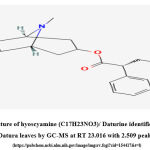 |
Figure 6: Structure of hyoscyamine (C17H23NO3)/ Daturine identified in the extract of Datura leaves by GC-MS at RT 23.016 with 2.509 peak %. |
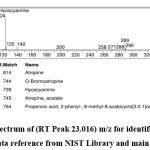 |
Graph 2: Shows MS spectrum of (RT Peak 23.016) m/z for identification of Hyoscyamine compound with data reference from NIST Library and main library of GCMS. |
Conclusion
The Phytochemical screening of plant in different extracts showed the presence of alkaloids, saponins, flavonoids and amino acids. The alkaloid spots were identified by TLC. The spectral data of GC-MS confirmed the presence of different compounds such Atropine, scopolamine, hyoscyamine and their chemical characterization. This study substantiate with the previous literature that the leaves of Datura stramonium are toxic in nature. In cases of poisoning by Datura stramonium in Bundelkhand region, the plant can be easily identified through botanical derived evidences such as leaf traces or plant extracts during the investigations of crime scene and is very fatal (1471 ug/kg) in men and eventually cause death, and contains high concentration of major tropane alkaloids as hyoscyamine and scopolamine.
Conflict of Interest
There is no conflict of interest including honorarium, grants, membership, employment, ownership of stock or any other interest or non‐financial interest such as personal or professional relation, affiliation and knowledge of the research topic between the authors.
Funding Sources
There are no funding sources for this article.
References
- Thabet H, Brahml N, Amamou M, BenSalah N, Hedhill A and Yacoub M. Datura stramonoium poisonings in humans. and Human Toxicol.1999; 41: 320-321.
- Shaikh AL. A. M and Sablay Z. M. Hallucinogenic plant poisoning in children. Saudi Med. J. 2005; 26: 118- 121.
- Karmakar RN: Forensic Medicine and Toxicology, 3rd Edition, Academic Publishers: Kolkata, 2010
- Haegi I, 1976. A taxonomic account of Datura L. Solanaceae in Australia with a note on Brugmansia Pers. Australian Journal of Botany, 24:415-435.
CrossRef - Chang S. S, Wu M. L, Deng J. F, Lee C. C, Chin T. F and Liao S. J. Poisoning by Datura leaves used as edible wild vegetables. and Human Toxicol.1999; 41: 242-245.
- De Frates L. J, Hoehns J. D, Sakornbut E. L, Glascock D. G and Tew A. R. Antimuscarinic intoxication resulting from the ingestion of moonflower seeds. The Annals of Pharm 2001; 39: 173- 176.
CrossRef - Dewitt M.S, Swain R and Gibson L B. The dangers of jimson weed and its abuse by teenagers in the Kanawha Valley of West Virginia. WV Med J. 1997; 93(4): 182-5
- Pillay V.V and Sasidharan A. Oleander and Datura Poisoning: An Update. Indian J Crit Care Med 2019;23 (Suppl 4):S250–S255
CrossRef - Roblot F, Montaz L, Delcoustal M, Gaboriau E, Chavagnat J. J, Morichaud G, Pourrat O, Scepi M and Patte D. Datura stramonium poisoning: The diagnosis is clinical, treatment is symptomatic Revue de Med. Interne. 2005; 16:187-190
CrossRef - Boumba A, Mitselou A and Vougiouklakis T. Fatal poisoning from ingestion of Datura stramonium Vet.and Human Toxicol. .2005; 46: 81-82
- Yadav RNS and Munin Agarwala. Phytochemical analysis of some medicinal plants. Journal of Phytology 2011; 3(12): 10-14.
- Berkov S, Zayed R and Doncheva T. Alkaloid patterns in some varieties of Datura stramonium. Fitoterapia. 2006; 77 (3):179-182.
CrossRef - Fecka I and Turek S. Determination of polyphenolic compounds in commercial herbal drugs and spices from Lamiaceae: thyme, wild thyme and sweet marjoram by chromatographic techniques. Food Chemistry. J Agric Food Chem.2008; 108 (3): 1039-1053.
CrossRef - Kheirollahi A, Tehrani M and Bashashati M. A comparison of the effect of intranasal desmopressin and intramuscular hyoscine N-butyl bromide combination with intramuscular hyoscine N-butyl bromide alone in acute renal colic. J Res Med Sci. 2010; 15(4): 214-218.
- Siddiqui S, Khurshid A, Roomi S, Karamat F, Khan A, Shaheen H and Yasmin T. Comparative analysis of hyoscine in wild-type and in vitrogrown Datura innoxia by high performance liquid chromatography” Tropical Journal of Pharmaceutical Research. 2017; 16(3): 1683-1692.
CrossRef - Kinsara A and El-Nasr M.M.S. Organization and Alkaloid Production in Tissue Culture of Datura innoxia Mill. J King Saud Univ Sci. 1994; 6(1): 5-15.
CrossRef







